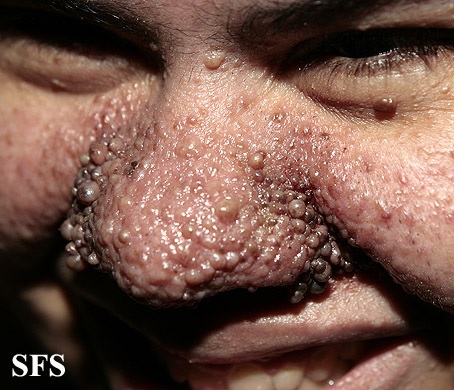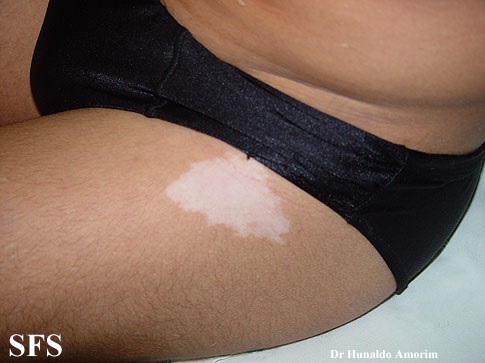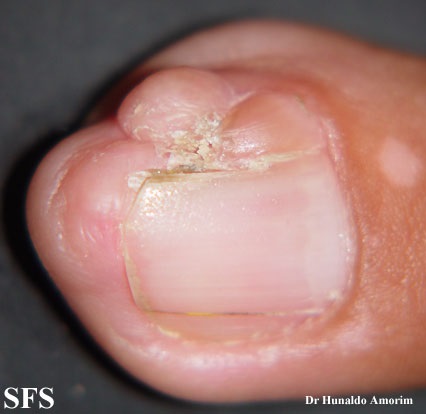Tuberous sclerosis history and symptoms: Difference between revisions
Jose Loyola (talk | contribs) |
Jose Loyola (talk | contribs) No edit summary |
||
| (One intermediate revision by the same user not shown) | |||
| Line 1: | Line 1: | ||
__NOTOC__ | __NOTOC__ | ||
{{Tuberous sclerosis}} | {{Tuberous sclerosis}} | ||
{{CMG}} | {{CMG}} {{AE}} {{Jose}} | ||
==History and Symptoms== | ==History and Symptoms== | ||
| Line 24: | Line 24: | ||
* Renal [[Angiomyolipoma|angiomyolipomas]] (present in 60-80% of the TSC patients), benign tumors composed of abnormal vessels, [[Smooth-muscle cell|smooth-muscle cells]] and fat cells which may cause [[hematuria]]. These tumors can be detectable in early childhood by [[Magnetic resonance imaging|MRI]], [[CT-scans|CT]] or [[ultrasound]]. Although benign, in TSC they are commonly multiple and bilateral. [[Angiomyolipoma|Angiomyolipomas]] larger than 4 cm are at risk for potentially catastrophic [[hemorrhage]] either spontaneously or with minimal [[trauma]]; | * Renal [[Angiomyolipoma|angiomyolipomas]] (present in 60-80% of the TSC patients), benign tumors composed of abnormal vessels, [[Smooth-muscle cell|smooth-muscle cells]] and fat cells which may cause [[hematuria]]. These tumors can be detectable in early childhood by [[Magnetic resonance imaging|MRI]], [[CT-scans|CT]] or [[ultrasound]]. Although benign, in TSC they are commonly multiple and bilateral. [[Angiomyolipoma|Angiomyolipomas]] larger than 4 cm are at risk for potentially catastrophic [[hemorrhage]] either spontaneously or with minimal [[trauma]]; | ||
* Epithelial cysts; | * Epithelial cysts; | ||
* Polycystic kidney disease (as 2-3% of the patients carries a deletion that affects both TSC2 gene and one of the genes that lead to autosomal dominant polycystic kidney disease); | *[[Polycystic kidney disease]] (as 2-3% of the patients carries a deletion that affects both [[TSC2]] gene and one of the genes that lead to [[autosomal dominant polycystic kidney disease]]); | ||
*[[Renal-cell carcinoma|Renal-cell carcinomas]] that may be diagnosed at a younger age (mean 28 years);<ref name=":0" /><ref name=":1">Crino PB, Nathanson KL, Henske EP (September 2006). "The tuberous sclerosis complex". ''The New England Journal of Medicine''. '''355''' (13): 1345–56. [[Digital object identifier|doi]]:10.1056/NEJMra055323. <nowiki>PMID 17005952</nowiki>.</ref> | *[[Renal-cell carcinoma|Renal-cell carcinomas]] that may be diagnosed at a younger age (mean 28 years);<ref name=":0" /><ref name=":1">Crino PB, Nathanson KL, Henske EP (September 2006). "The tuberous sclerosis complex". ''The New England Journal of Medicine''. '''355''' (13): 1345–56. [[Digital object identifier|doi]]:10.1056/NEJMra055323. <nowiki>PMID 17005952</nowiki>.</ref> | ||
* Patients ≥18 years may have higher rates of [[chronic kidney disease]], [[hematuria]], [[kidney failure]], [[embolization]] (EMB), and partial and complete [[nephrectomy]] compared to patients <18 years.<ref>Song, Xue, et al. "Natural history of patients with tuberous sclerosis complex related renal angiomyolipoma." ''Current medical research and opinion'' 33.7 (2017): 1277-1282.</ref> | * Patients ≥18 years may have higher rates of [[chronic kidney disease]], [[hematuria]], [[kidney failure]], [[embolization]] (EMB), and partial and complete [[nephrectomy]] compared to patients <18 years.<ref>Song, Xue, et al. "Natural history of patients with tuberous sclerosis complex related renal angiomyolipoma." ''Current medical research and opinion'' 33.7 (2017): 1277-1282.</ref> | ||
Latest revision as of 17:56, 23 June 2020
|
Tuberous sclerosis Microchapters |
|
Diagnosis |
|---|
|
Treatment |
|
Case Studies |
|
Tuberous sclerosis history and symptoms On the Web |
|
American Roentgen Ray Society Images of Tuberous sclerosis history and symptoms |
|
Risk calculators and risk factors for Tuberous sclerosis history and symptoms |
Editor-In-Chief: C. Michael Gibson, M.S., M.D. [1] Associate Editor(s)-in-Chief: José Eduardo Riceto Loyola Junior, M.D.[2]
History and Symptoms
Skin
Symptoms develop in almost all patients with TSC and include:[1]
- Ungual fibromas;
- Facial angiofibromas (may demand treatment and may worsen with UV exposure);
- Shagreen patches (oval-shaped lesions, generally skin-colored but can be sometimes pigmented, may be crinkled or smooth);
- Hocal hypopigmented macules (ash-leaf spots);
- Dental enamel pits (present in 100% of the patients);
- Oral fibromas;
Ocular
- Retinal astrocytic hamartomas (tumors of the retinal nerve);
- Retinal achromic patches (light or dark spots on the eye).[1]
Renal
- Renal angiomyolipomas (present in 60-80% of the TSC patients), benign tumors composed of abnormal vessels, smooth-muscle cells and fat cells which may cause hematuria. These tumors can be detectable in early childhood by MRI, CT or ultrasound. Although benign, in TSC they are commonly multiple and bilateral. Angiomyolipomas larger than 4 cm are at risk for potentially catastrophic hemorrhage either spontaneously or with minimal trauma;
- Epithelial cysts;
- Polycystic kidney disease (as 2-3% of the patients carries a deletion that affects both TSC2 gene and one of the genes that lead to autosomal dominant polycystic kidney disease);
- Renal-cell carcinomas that may be diagnosed at a younger age (mean 28 years);[1][2]
- Patients ≥18 years may have higher rates of chronic kidney disease, hematuria, kidney failure, embolization (EMB), and partial and complete nephrectomy compared to patients <18 years.[3]
Pulmonary
- Lymphangiomyomatosis affects mostly women and is a proliferation of smooth-muscle cells that may result in cystic changes in the lungs. Recent genetic analysis has shown that the proliferative bronchiolar smooth muscle in TSC-related lymphangioleiomyomatosis is monoclonal metastasis from a coexisting renal angiomyolipoma. Cases of TSC-related lymphangioleiomyomatosis recurring following lung transplant have been reported.[4] Diagnosed mostly during early adulthood, may cause pneumothorax.
- Multifocal micronodular pneumocyte hyperplasia can occur in both men and women and are mostly asymptomatic.[1][2]
Neurologic
These manifestations are one of the major causes of morbidity in patients with TSC.
- Epilepsy, which is the most common neurological presentation occurring in 70-80% of patients and may complicate with infantile spasms, a severe form of epileptic syndrome. If epilepsy presents with an early onset t is associated with cognitive disabilities, which are also very prevalent in such patients. In 2020 a paper showed that epilepsy remission by appropriate treatment in early life can possibly prevent autism and intellectual disability.[5]
- Neuropsychiatric disorders are present in two-thirds of the patients and anxiety is one of the most common presentations. Autism is one possible manifestation and is especially associated with cerebral cortical tubers. It consists of neurologic tissue that grows in a different pattern, losing the normal six-layered cortical structure, with dysmorphic neurons, large astrocytes and giant cells.
- Subependymal nodules;
- Subependymal giant cell astrocytomas, which may cause obstructive hydrocephalus. Risk of such benign tumors decreases after age of 20.[2][1]
Cardiovascular
Rhabdomyomas may be present, being intramural or intracavitary in its distribution along the myocardium. May be detected in utero on fetuses and is associated with cardiac failure. Often disappear spontaneously in later life.[1] 80% of children under two-years-old with TSC have at least one rhabdomyoma, and about 90% of those will have several.[6]
Prognosis
- The prognosis for individuals with TSC depends on the severity of symptoms, which range from mild skin abnormalities to varying degrees of learning disabilities and epilepsy to severe mental retardation, uncontrollable seizures, and kidney failure.
References
- ↑ 1.0 1.1 1.2 1.3 1.4 1.5 Henske, Elizabeth P., et al. "Tuberous sclerosis complex." Nature reviews Disease primers 2.1 (2016): 1-18.
- ↑ 2.0 2.1 2.2 Crino PB, Nathanson KL, Henske EP (September 2006). "The tuberous sclerosis complex". The New England Journal of Medicine. 355 (13): 1345–56. doi:10.1056/NEJMra055323. PMID 17005952.
- ↑ Song, Xue, et al. "Natural history of patients with tuberous sclerosis complex related renal angiomyolipoma." Current medical research and opinion 33.7 (2017): 1277-1282.
- ↑ Henske EP (December 2003). "Metastasis of benign tumor cells in tuberous sclerosis complex". Genes, Chromosomes & Cancer. 38 (4): 376–81. doi:10.1002/gcc.10252. PMID 14566858.
- ↑ Gupta, Ajay, et al. "Epilepsy and neurodevelopmental comorbidities in tuberous sclerosis complex: a natural history study." Pediatric Neurology (2020).
- ↑ Hinton RB, Prakash A, Romp RL, Krueger DA, Knilans TK (November 2014). "Cardiovascular manifestations of tuberous sclerosis complex and summary of the revised diagnostic criteria and surveillance and management recommendations from the International Tuberous Sclerosis Consensus Group". Journal of the American Heart Association. 3 (6): e001493. doi:10.1161/JAHA.114.001493. PMC 4338742. PMID 25424575.


